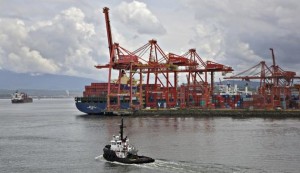Prospects for Canada’s economy dimmed on Tuesday with news that activity by purchasing managers nosedived unexpectedly in December, while the country posted a big trade deficit a month earlier.
The double dose of bearish news helped push the Canadian dollar to its weakest level against the U.S. dollar since 2010. The currency – already hit by the poor trade figures – fell to C$1.0763 to the greenback, or 92.91 U.S. cents, down from C$1.0713 to the U.S. dollar, or 93.34 U.S. cents, just before the purchasing figures were released.
In late October the Bank of Canada – concerned about the economy’s sluggish performance and low inflation – said it expected annualized GDP growth in the fourth quarter to be 2.3 percent, down from 2.7 percent in the third.
Market analysts have long predicted that Canada will benefit from an increasingly strong U.S. recovery. But the Ivey Purchasing Managers Index showed activity in Canada contracted sharply and unexpectedly in December, its second straight dismal monthly performance.
The seasonally adjusted index fell to 46.3 from 53.7 in November, contrary to analysts’ expectations for a rise to 54.5. A figure below 50 shows a fall in purchasing activity. The news did little to cheer a currency market already unnerved by news that Canada had posted a November trade deficit of C$940 million ($879 million). The deficit – the 23rd in a row – was significantly bigger than the C$140 million shortfall forecast by market experts.
One reason for the jump was that Statistics Canada revised October’s initial surplus of C$75 million to a deficit of C$908 million, in part to reflect revised data on crude oil prices. Initial trade statistics for any given month include estimates of crude prices rather than hard figures.
The value of exports was unchanged from October as volumes fell by 0.7 percent, while imports increased by 0.1 percent on flat volumes. Since the 2008/09 recession, exports have struggled with a strong Canadian dollar and weak markets. “Back to the abyss for Canadian trade,” read the headline of a note to clients from TD Securities strategist Mazen Issa. Before Statscan’s drastic October revision, the trade balance had been improving for three straight months.
Bank of Canada Governor Stephen Poloz – who has said that near record-low interest rates will not rise until economic growth picks up – told Reuters last month that the main risk to the outlook for the domestic economy in 2014 was that exports would not recover as anticipated.
“Weakness in net exports highlights the elusiveness of the recovery and provides reaffirmation of the Bank of Canada’s dovish bias,” Issa said.
Exports to the United States, which comprised 75.3 percent of all Canadian exports in November, rose by 0.6 percent, while imports rose by 2.0 percent to hit a record high. As a result, the trade surplus with the United States fell to C$2.75 billion from C$3.08 billion in October.
“Given the sizeable downward revision to October exports, it doesn’t look as though trade will be adding anything to fourth quarter growth,” Benjamin Reitzes of BMO Capital Markets Economics said in a note.
Peter Hall, chief economist at Export Development Canada, noted that exports of motor vehicles and parts rose by 9.6 percent in November from October while shipments of aircraft as well as wood products also grew.
“That speaks to the fundamental strength of the U.S. economy,” he told Reuters, noting that the after-effects of a U.S. government shutdown last year had stretched into October and November. “It still looks like temporary weakness to us and December and January could see a turnaround.”
The cumulative trade deficit for the first 11 months of the year was C$8.88 billion, well below the record January-November shortfall of C$12.00 billion posted in 2012. By David Ljunggren (Reuters) (Additional reporting by Cameron French and Alastair Sharp in Toronto; Editing by Nick Zieminski; and Peter Galloway)
photo: Reuters – A tugboat heads out into the harbour beside the container port in Vancouver, British Columbia June 8, 2012. REUTERS/Andy Clark













